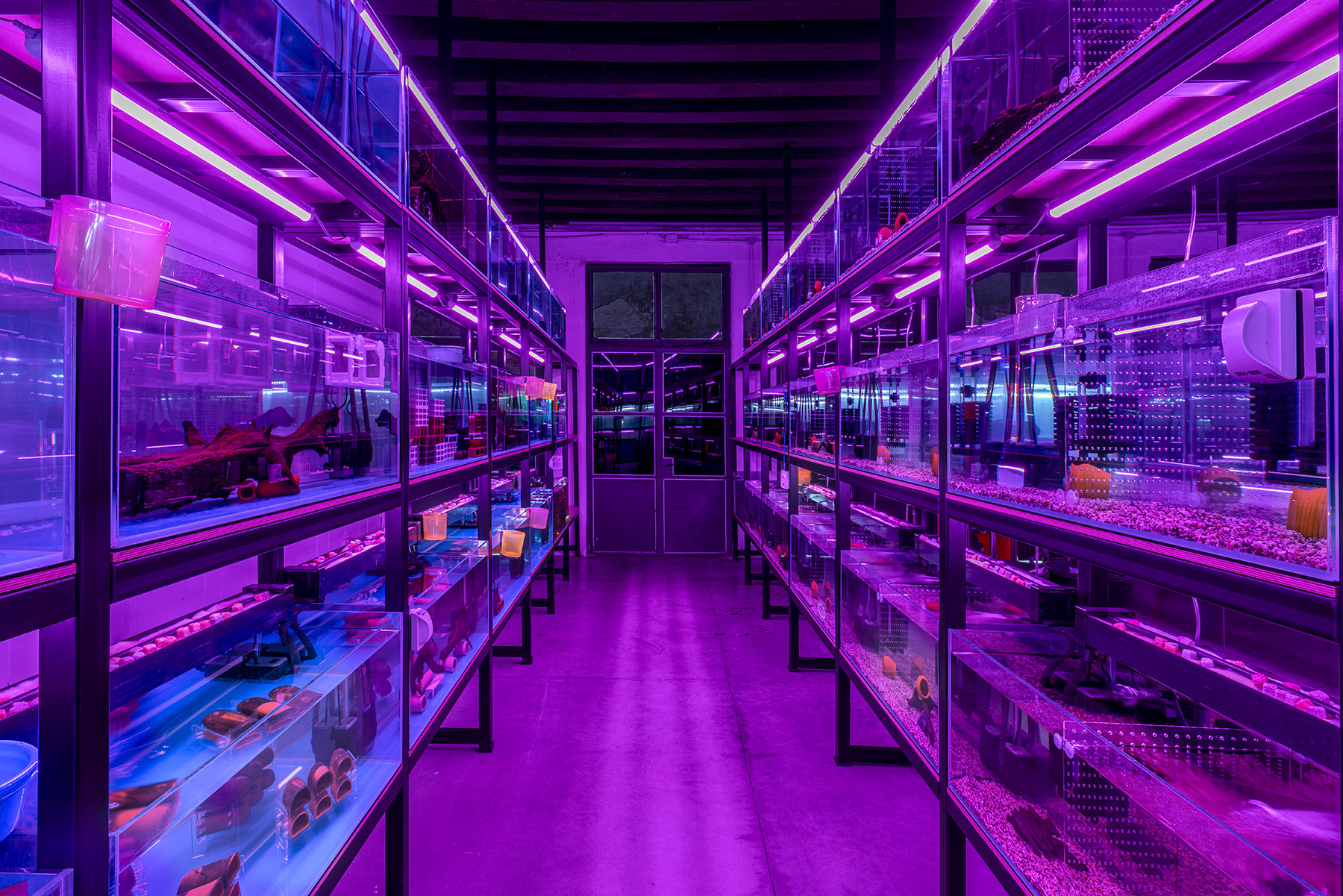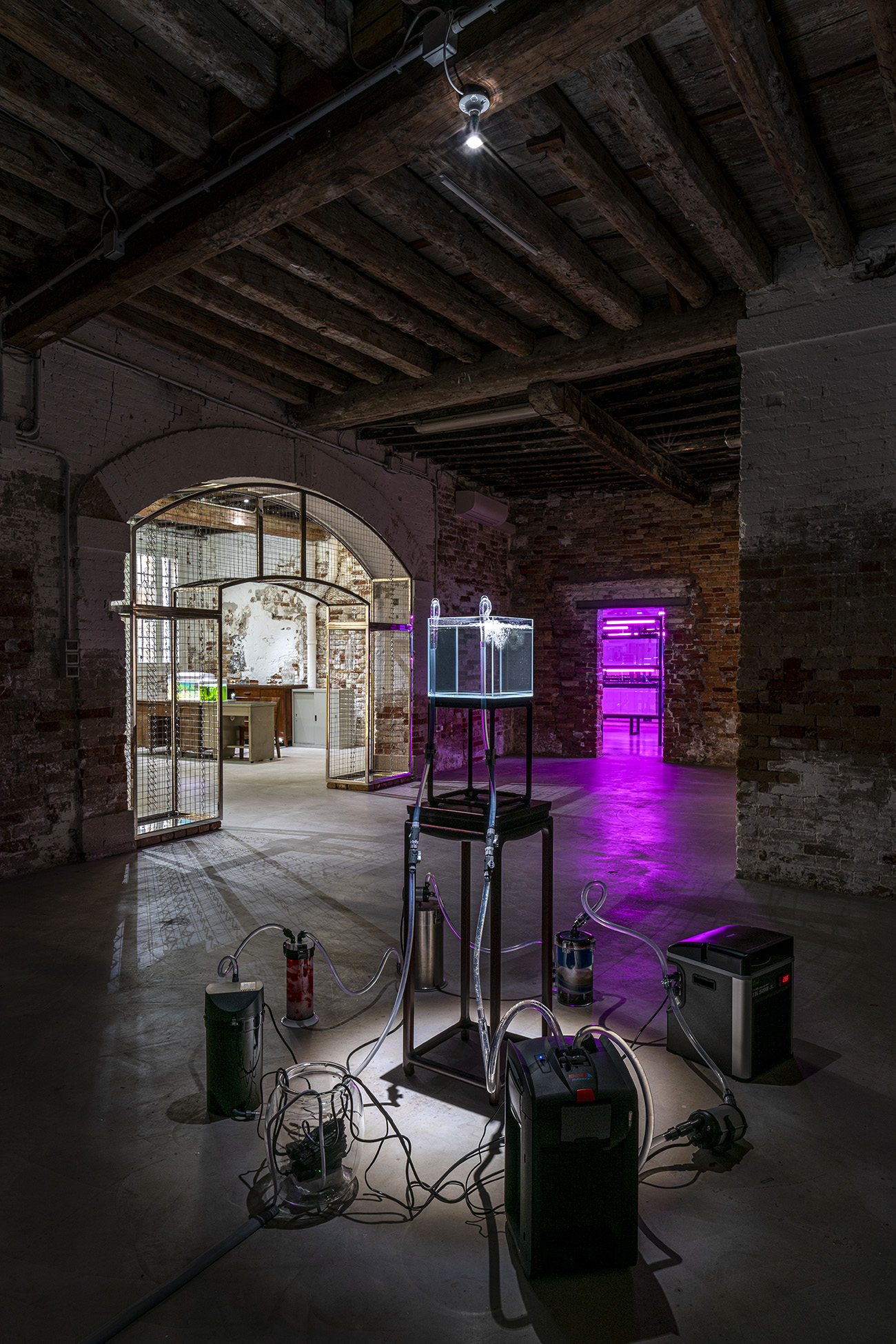Trevor Yeung celebrates elements of Hong Kong’s popular culture in his Venice Biennale of Art 2024 showcase, inviting audiences to see the world from the point of view of aquarium fish. Chitralekha Basu reports.

Trevor Yeung is more interested in peripheral matters, as opposed to tackling the big global issues head-on. While exploring “the relationship between human beings and the ecological system” is at the heart of his practice, Yeung says he prefers “to take a step back from such a heavy and complicated idea” instead of addressing it directly.
“When I approach a subject, I tend to take away one bit of information that may not be the most important thing about it and amplify that minor aspect,” he says on a video call from Campo della Tana, Castello, the venue of his solo exhibition, Courtyard of Attachments. Curated by Olivia Chow, Courtyard is a Venice Biennale of Art 2024 collateral event supported by the Hong Kong Arts Development Council and the M+ museum. The so-called minor element dominating Yeung’s Venice showcase is the use of fluorescent lights — a reference to the typical lighting in Hong Kong’s goldfish retail shops. One of the installations in the exhibition, Cave of Avoidance (Not Yours), comprises over 40 stacked aquariums, filled with water and other paraphernalia associated with the retailing of aquarium fish, such as nets, colorful baubles, plastic mugs and tubs and terracotta fish breeding apparatus. Awash with strong fluorescent lights and yet the room presents a picture of dereliction. The stage is set. The props are in place. But there isn’t a single fish in sight.
READ MORE: Hit the reset button

The room exudes a cold, humid vibe — enhanced by the millions of tiny bubbles formed on the walls of plastic aquarium accessories — heightening the overarching sense of abandonment. Yeung, however, points out that the empty aquariums could also be viewed as awaiting the arrival of fish. “There is no way of knowing if the scene suggests a beginning or an ending,” he says. “I think the absence of fish allows the audience more space to ponder about the situation and reflect on the possible relationships they could have developed with aquarium fish.”
If Yeung talks of owners connecting with fish kept in aquariums on an emotional level, it is because he has been there himself. As a socially awkward Guangzhou-born young person growing up in Hong Kong in the ’90s, he always felt more at home spending time with his pet fish. Over time, caring for household plants and aquarium fish led him to develop an empathetic understanding of the ways in which they thrive best, which, in turn, has shaped his artistic practice.

Through the lens of nature
“Yeung’s conceptual art practice is unique in that he creates installations and mixed-media works using horticulture, aquariums and found objects to draw comparisons between a domesticated natural world and the society we reside in,” says Mimi Chun, founder and director of Hong Kong’s Blindspot Gallery, which represents the artist.
She is referring to the way Yeung often places a slice of nature inside a domestic set-up, using nature as a lens to explore the human condition. For instance, the centerpiece of Mr Cuddles in a Hotel Room, one of the installations in Yeung’s Sigg Prize 2023 entry and on display at M+ until recently, features a money tree in harness and hung diagonally from the ceiling. The plant’s tightly braided exposed roots and the precarious nature of its suspended state is meant to chime with the uncertainty and angst suffered by Hong Kong returnees who were forced into a long quarantine during the COVID-19 pandemic.

Similarly, Courtyard invites the audience to tap into their negative capabilities — imagine “being a fish inside a fish tank and seeing the world from the perspective of a fish”. Yeung says that “the idea is to have the audience see themselves as part of the work”. The abundance of water and mirrored surfaces that reflect, and also refract, images of the visitors to the exhibition is meant to aid this process. From Pond of Never Enough — a fountain made out of stacked aquariums placed in the courtyard at the entrance to the exhibition — to the recycled buckets fitted with solar panels and containing miniature self-sustaining lotus “gardens” scattered all around it, throughout the exhibition there is no dearth of reflectors where visitors can catch a glimpse of themselves as well as, as Yeung points out, “of others watching their reflections”.
The presence of the lotus gardens, which are easy to miss at this time, as the leaves will appear in summer and the flowers will bloom only in autumn, is a quiet nod to the artist’s perennial concern for protecting the environment. Buckets used to collect industrial or construction waste, which, more often than not, is nonbiodegradable, have been recycled as planters to grow the lotus plants — symbolizing a beautiful journey toward embracing sustainable lifestyle practices.

Shape of water
The more obvious championing of sustainable lifestyle practices is in the way water is sourced, used, filtered and recycled in Courtyard. The water used for the fountain in Pond of Never Enough is harnessed from the Grand Canal. Designed after the large containers with metal rings used to breed fish in Hong Kong, the fountain is fitted with a double-layer filtering mechanism at its base. The impurities are left behind while the filtered water goes back to the Venetian Lagoon.
In Yeung’s elaborate theater referencing several stages in the life cycle of farmed fish — from spawns to objects displayed in aquariums to food waste — water has the key role. The artist takes on the role of the director-choreographer, making water dance to his tune in Courtyard. And as is common with live performances, there is an element of unpredictability, adding unforeseen twists to the show.

For instance, the high mineral content in Venetian tap water, used for the indoor installations, left its mark on some of the works. “Three days after we started using tap water, we found a lot of mineral residues at the bottom of the aquariums in Cave of Avoidance (Not Yours),” Yeung says. The creative team took an impromptu decision “to let the mineral content collect at the bottom of the aquariums, which are fitted with mirrors”.
“The base now looks like it’s covered with rubble from an earthquake. So in this case, it’s not just me playing around with water, but also the water displaying certain characteristics specific to the location of this exhibition,” Yeung says. “The audience can actually experience how water responds to the materials it comes in contact with.”

Homage to Hong Kong quirks
Some of the most familiar elements of Hong Kong popular culture are presented in an atypical fashion in Courtyard. Feng shui objects like rotating ball fountains appear with their motors exposed. The transparent plastic bags used to bring home goldfish from retail shops are shown as perforated and dripping water. Mushroom-shaped plastic lights pop up randomly, sometimes in obscure corners that are easy to miss.
Yeung hastens to assert that the references to Hong Kong culture in his works are not intended to be satirical. “They are a part of my life and reflect who I am as a person. All those things, including the aquariums and the crystals in the rotating ball fountains, are a part of the Hong Kong milieu I grew up in.”
ALSO READ: Road to eternity
According to Chun of Blindspot Gallery, the mushroom lights, which are a staple of Yeung’s works, “serve as a metaphor for those who live outside the system, and not necessarily within it” — a bit like the artist himself, who hasn’t shown any inclination to jump onto the art-tech bandwagon, as most of his Hong Kong peers are doing.
“My focus is on emotions, on making connections, and also the nature surrounding us. New technology is definitely not what I’m focusing on,” Yeung says. “Rather than new technologies, I’m more interested in where it all started.”
If you go
Trevor Yeung: Courtyard of Attachments
Dates: Through Nov 24
Venue: Campo della Tana, Castello 2126, 30122, Venice


